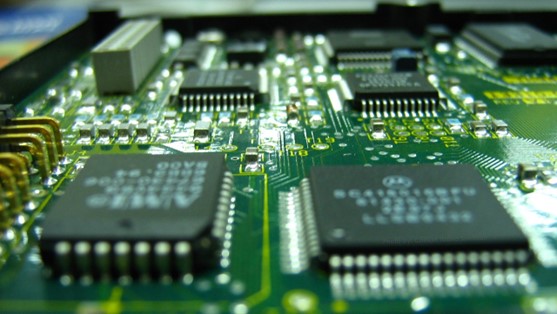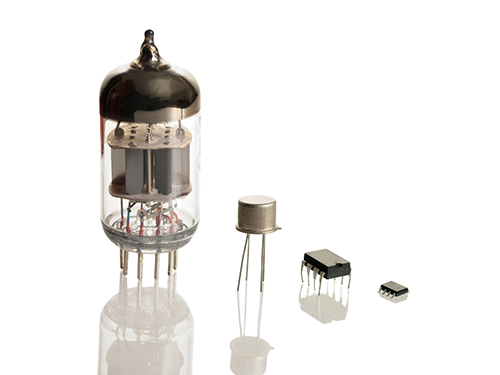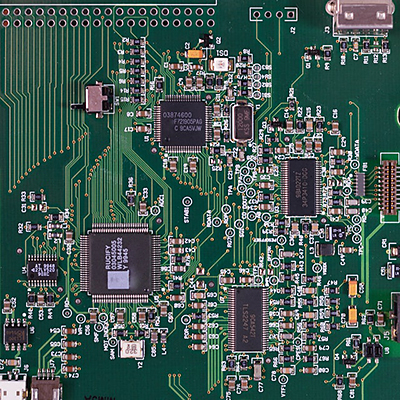
Overview
This is where we describe the device that controls the flow of electricity inside the semiconductor so that the bit patterns (bytes) can become the language that the computer will translate into human literacy, or in layman’s terms, translate from bytes to English characters, numbers, and special characters.
Driving the Current
You might say electricity hates semiconductors because current can only travel through them when you tell it to, or more specifically when you turn a switch on or off. It is similar to driving a car. You can’t drive down the road and not think there will be any obstacles such as a red light to stop you.
A good example is to picture your car as the current and the road as the semiconductor. Now imagine a light bulb at the end of the road. If the current (your car) continues to travel down the road without hitting a stop light, you will reach the bulb, and voila! You (the current) reached the bulb and lit it up.

But what if there was a red light on the road? You must stop the car (stop the flow of current) and then there is no voila. The bulb will not light because no electricity was allowed to continue down the road to reach it.
Another analogy is when you turn on a faucet to allow water to flow. When you are done, you turn it off and the water stops flowing, but you can also control the speed or force at which the water comes out. It is this force that can be equated to voltage when referring to electricity. Let’s look at this in a bit more detail.
The Voltage Factor
So the flow of electricity that is controlled through the semiconductor is via the amount of voltage that is being used. If too little voltage is implemented, then no electrical current will flow through, but if you raise the voltage, it will trigger the semiconductor to open the gate and allow the current to flow through. In other words, voltage is the controlling factor in whether current will or will not flow through the conductor.
The Managing Device Within the Semiconductor
This control of whether current flows or doesn’t flow through a semiconductor has a name – transistor, which is nothing more than a switch to allow or disallow electricity to travel through it. The transistor will open when a specific amount of voltage (force) is used but will close when not enough voltage is used.
Before semiconductors were introduced, transistors were controlled by vacuum tubes. They were large, bulky devices, but they worked the same way as today’s tiny transistors do. You may recall seeing old photos of large rooms filled with vacuum tubes. That’s what it took to just make some simple calculations.
Transistor Sizes as Compared Throughout the Decades. Top-Left is a vacuum tube that would represent one transistor., equating to one state of either on or off. The rightmost device is a semiconductor computer chip that can contain hundreds or even thousands of transistors with simultaneous on and off states. Photo vlabo from iStock
Today’s transistors are tiny and the hundreds, if not thousands of vacuum tubes that filled a room can now fit on a computer chip the size of your fingernail. These ‘chips’, sit on a board, called a motherboard that connects the circuits which allow the current to run along with it.

The transistor’s on and off states create logic that represents the basic building blocks of the decision making process; however, we don’t refer to this process as on or off. Instead, we represent it by numbers. ‘1’ represents ‘on’ and ‘0’ represents ‘off’, which in computer talk are called bits.
Our article on how bits and bytes work explains this in more detail.
What are Semiconductors Made Of?
Transistors are made of silicon and germanium, an element typically found in sand. The physical characteristics of silicon and germanium can be perfect conductors to allow current to flow without much resistance, but can also be perfect insulators to stop any current from flowing, which makes it a truly superior mineral when you need to control electricity.
Summary
Transistors allow current to flow or not to flow through it. The material that the current resides in is silicon, which is used because its properties allow it to work well as a conductor but just as well as an insulator. Each on or off state is represented by a ‘1’ or ‘0’ and is called a bit. Eight bits make a byte, and it is the particular pattern of bits in each of the bytes that determines a certain instruction for the computer to follow.
